| February 2008 Index | Home Page |
Editor’s Note: There is, in teaching and learning, considerable difference between “interactive” and “immediate” feedback. Skillful use of technology can compensate for loss of direct personal contact in the web-based world.
Redesigning Online Instruction:
Theory and Application
Catherine Gouge
USA
Keywords: distance learning, online courses, online course design, online program administration, online instructors, pedagogy, web-based course technology, editing, online writing, course redesign, adult learners
Introduction
Many colleges and universities have been engaged in the process of redesigning on-site, or “traditional,” course offerings and developing web-based courses for nearly a decade now. In fact, until fairly recently, if a web-course designer spoke of “re-designing” a course, he or she was probably referring to this process of transforming an on-site class into a fully or partially online course. In 2003, the National Center for Academic Transformation at Rensselaer Polytechnic Institute concluded a four year study called the “Pew Grant Program in Course Redesign” which followed ten different post-secondary institutions in a variety of disciplines through three “rounds” of “redesigning” traditional courses to make significant use of the web.[1] The results of these kinds of redesign processes have been dramatic: according to the last report on distance education prepared by the Sloan Consortium, approximately 3.2 million students were enrolled in at least one online course in 2005. This study also reports that the online enrollment growth rate (including both 100% online and hybrid courses) was over ten times that projected by the National Center for Education Statistics for the entire post-secondary population.
As a result of the remarkable growth and popularity of online course offerings, many institutions have also begun the substantial and strategically different challenge of re-designing already existing online courses. This essay is concerned with this more recent process of redesigning, one which requires careful reflection both on the original course design and on the philosophy motivating past and future design choices. In many instances, the primary goal for early web-based course design was simply to get courses online. However, course designers and program coordinators now have the benefit of an established history of reflecting on web-based delivery (Conti, 2004; Hammond & Trapp, 2002; Salemi, 2006; Wily & Schooler, 2000) and, consequently, the advantage of thinking more critically and focusing not just on the mode of delivery but on the logical structure of the content of individual online courses.
Because many of the people responsible for current redesign processes are faculty members who may or may not be working with technical support from another department on campus[2], contemporary redesigners, I argue, ought to prioritize program integrity over other interests like cost efficiency and technological experimentation. This is not to say that those interests are not important, but I do mean to assert that they should be balanced by an explicit emphasis on intellectual course and program content. Program integrity, furthermore, ought to be defined primarily in terms of student learning and faculty satisfaction. If we let these qualitative measures motivate our decision-making and use success in these areas as the primary indicators of programmatic integrity, we can help create the conditions under which cost efficiency and technology work in the service of student learning and faculty satisfaction and not the other was around. Pressures from others at our home institutions whose job it is to maximize revenue will obviously help define the parameters within which we must work, but it is our job, as the program subject matter experts, to foreground the program content and the involved students and faculty in the redesign process.
Let us say that if one does want to approach the redesign process in this way, where would we begin, practically speaking, and what would that process look like? Once we decide to approach the redesign process with the overarching goal of “program integrity” as I have defined it, we then need to formulate a practical and specific design approach to begin our revision of the course(s). To illustrate how this might unfold, I will describe my most recent redesign experience with an online editing course which helped me to realize the benefits of deriving my redesign approach from the course specific content and program goals. Doing so has the potential to allow the resulting courses to lead by example, using the course structure and conduct (not just its content) to reinforce goals for student learning. For example, if analyzing rhetorical contexts and revision strategies are important skills for students to learn in the course(s) we are working with, doing so ourselves is more likely to result in a course which reflects our attention to those goals and is, therefore, a model of those processes. If this is accomplished, I argue, the resulting course will be one that more effectively motivates student learning, faculty satisfaction, and, therefore, program integrity.
The Context for My Redesign Process
At West Virginia University for the past five years, I have designed, piloted, and coordinated six 100% online sections of the required writing courses part-time adult students can take to fulfill university general education requirements or to complete a Professional Writing and Editing (PWE) Concentration/ Minor/ Certificate. With those courses now fairly established and with the benefit of being able to look at the history of those courses and what has worked and not worked, I have begun the process of doing some major refiguring of the course structures and technological infrastructures.
The PWE requirements include the standard freshman composition course (English 101), a research writing course (English 102), an advanced rhetoric course (English 201), the editing course (English 302), professional writing (English 304), technical writing (English 305), and an internship (English 491A). The editing course was the fourth course in the series I designed over a two year period beginning in 2001. The design approach I used for each of the courses was intentionally pretty low-tech. Courses made extensive use of variety of the most simple communication components of WebCT Campus Edition, our original course management system (CMS): WebCT’s internal email, bulletin board, and chat rooms were used for weekly whole class and small group discussion; and assignments were put on the web as simple html text files for students to read, download, and print. The original goal in designing the sequence was to make it easy for adult learners, primarily in the state of West Virginia, to be able to take the courses without needing super expensive, high-end technology or tech know-how. In other words, accessibility was of primary importance.
The Existing Course Design
The existing structure of the editing class included weekly reading, practice, and discussion. Assessment in the first half of the term consisted primarily of short online quizzes covering the weekly reading through the CMS. Students completed four of these quizzes before midterm, at which point they would take an online midterm exam which asked them to complete short answer analysis of editing concepts and to choose among some multiple choice answers covering all they have read so far about editing, grammar, and mechanics. Assessment in the second half of the term consisted primarily of a series of four editing projects, beginning with simple copy or line editing and progressing to more complex comprehensive editing or professional texts. These editing projects were printed by the students through WebCT, completed in hard copy with pens, and submitted to me via the postal service.
The entire term was organized into sixteen “Weekly Modules”—one for each week of the term—which told students what to read, write/post, practice, and send/email. Their deadline each week was always on the same day and time: Monday at 10 p.m.[3]
Figure 1 shows what a typical “Weekly Module” looks like:
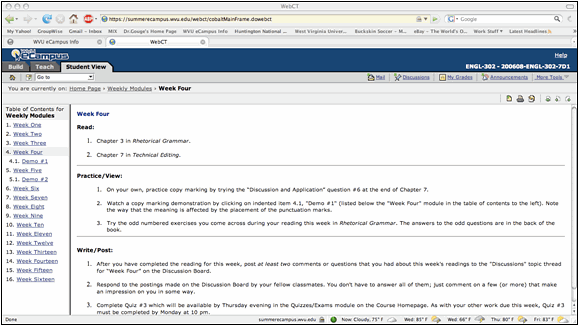
Figure 1. A Typical Weekly Module.
Redesign of “Technical Editing”
I began the process of redesigning our online writing courses, not with the first and lower-level writing course I designed and piloted but with one of the last: “Technical Editing.” The first version of the course was launched in 2002. The reason I began with this course is that it has historically attracted advanced students with web-course experience since it has as its prerequisites two of our other, lower-level web-based writing courses (English 101 and 102). It is also a course that, due to its content involving copy-marking symbols, was still dependent on snail mail as a method of submitting some editing assignments and receiving feedback. There is not yet to my knowledge any commercial instructional product which can electronically record student-generated copy-marking symbols. My task, then, was to revisit the course structure and work on revising the course so that it could be 100% electronic if possible.
To support the over-arching, flexible logic of prioritizing program integrity, I believe it is important for the course structure to support and parallel that which the course is meant to teach. In other words, course structure should reinforce and even parallel course content. Because the editing class that was the focus of my redesign process is a part of a Professional Writing and Editing program housed in the English Department at WVU, our goals for the class are rooted in the importance of the rhetorical context to effective writing and editing. All of the courses in the PWE sequence are meant to teach students about the importance of recognizing and analyzing different professional rhetorical contexts. According to my proposed logic of course redesign, then, the course structure should be such that rhetorical context is valued and foregrounded in the course pedagogy.[4]
Not accidentally, therefore, my process for revising the editing course was driven by one of the processes the course is meant to teach students: the editing process. This was particularly helpful since, whereas the first time around I had no existing course/text to work from, however, during the re-design process I had an existing on-line course/text to work with much like an editor who has an existing text to help shape. The textbook I use for the on-site version of the course is Carolyn Rude’s Technical Editing (2005). In her discussion of the “comprehensive” editing process, she suggests that students work through the following steps: 1) Analyze the readers, uses, and purposes; 2) Evaluate the text according to content, style, visual design, and other criteria; and 3) Translate that evaluation into goals or objectives for the revision process. Because this process is essential to what I wanted my students to learn, I invoked it from the beginning of my process, explicitly using it to shape my process of redesigning the course and, therefore, the resulting structure of the course itself.
The Analysis
Readers
The first step in my process was to analyze the student population who would be the primary audience for the course. I had, of course, done an analysis of our target student population when the course was first designed, but I now had more experience with the student population and more survey information on which to base my analysis. From these sources, I found out that nearly 90% of my students are now accessing the course via broadband access. Five years ago when the course was first designed, the percentage of students with access to a high-speed Internet connection was roughly 40%. My student population has not changed a great deal in terms of age (95% are between 25-50 yrs. old) and gender (approximately 80% are women) and work responsibility (roughly 90% work full-time). As many have noted (Brookfield, 2000; Conti, 2004; Knowles, 1970; Rhoda, 2005), adult learners can have specific motivation, access issues, and anxieties which influence their learning in online courses, so I needed to continue to keep that in mind. However, where students are and why they are taking the course has changed. We have recently had students enrolled in our online writing courses who are military personnel stationed in Iraq and others as far away as France and Lebanon. Many of them are returning to school after many years. The majority are adults who have been taking courses over a period of many years while working and tending to family responsibilities.
Perhaps the most significant difference between now and then is that this editing course will not be the first online course for most of our current student population, as it was likely to have been four years ago. Many of our students have taken multiple online courses, most of them using the same course management system: WebCT (now Blackboard). This is significant because I can assume a slightly higher level of technological savvy and, in particular, familiarity with our licenced CMS. This has the potential to free us from having to teach both the writing course content and how to perform basic skills for discussion and assessment in the course. It also means that we might consider adding more sophisticated tech elements without making the tech aspects of such course elements too distracting.
Uses
Though some students do take the editing course to fulfill a 300-level course requirement and to have the opportunity to review the rules of grammar and mechanics again, increasingly, many of them are interested in taking an editing course as a part of the Professional Writing and Editing Certificate. This means that they are interested in learning the language of copy-marking and proofreading symbols, the vocabulary of the editing process, and the increasingly more common practice of electronic editing.
A number of the students who enroll in the online editing are currently working in jobs that require editing, though it was not initially part of the job description. These students don’t consider themselves “editors,” per se, but they have tried on their own to figure out how to be one for their current place of employment none the less. These students are anxious to see if the editing work they have been doing was sufficient and to learn new skills that will make them more adept at this aspect of their jobs. Other students have not had the opportunity to explicitly study grammar or punctuation in for many years and are anxious to revisit basic rules they are expected to remember from middle school so that they can do well in their upper-level classes.
Purposes
The entire sequence of online PWE courses was originally and still is intended to provide students, who might not otherwise have access to coursework, the opportunity and flexibility to take solid and sound writing courses, not versions of the courses that are less-than or watered-down on-site clones but courses which helped students achieve the learning outcomes we had determined were important to each of the courses regardless of their delivery method. Our program’s specific goals for “Technical Editing” are to help students build a solid foundation in and learn to analyze the basic principles, processes, and vocabulary of technical editing. These are rhetorical skills which can be applied to many areas of their professional and academic activities, but the specific focus in this course is to work with the other courses that constitute a Professional Writing and Editing concentration, minor, or certificate in the English Department. As our current provost has said to me, we want our adult learners and traditional students alike to have a rewarding experience going to college, not just getting through college. This means that we want to provide them with a variety of learning opportunities that motivate them to really engage with the course material, not just pass by it with a passing grade.
Evaluation
Once I had revisited and reflected on our student population, their ways of interacting with the course, and our goals for student learning in the course, I was prepared to evaluate my existing course. What I found in my analysis was that too much of the course relied on the postal service, or “snail mail,” for the exchange of student work. This is ineffective and undesirable for a number of reasons connected to my analysis of our audience, uses, and purposes.
First of all, as my analysis determined, where our students are had changed in such a way that the relatively slow postal service would severely limit access to timely feedback for those students in the military stationed overseas and for those in other countries wanting to take full advantage of the internet as delivery method. It is possible with students taking online courses from inside the state of West Virginia for them to mail me a copyediting project and receive it back from me before their next is due two weeks later. For students outside the state or country, this would be nearly impossible and would impose an unfair disadvantage on their learning process.
Secondly, why students are taking the course had also changed in a way that might make the “snail mail” method of exchange less effective. Many students enrolling in the course are currently working and are required informally to perform both hardcopy and electronic editing. Especially as electronic editing and collaboration in the writing process become more common, these students need more experience of working with electronic editing techniques and technologies than those in the early years of the course.
Thirdly, because many of our current students will have taken multiple online courses by the time they get to “Technical Editing” and we can, therefore, assume a slightly higher level of technological savvy, I can safely raise the bar on the minimum level of tech skills required to take the course. Perhaps more importantly, I can reconsider making use of more complex technologies if doing so would help facilitate the course goals. The level of tech savvy and access needn’t be quite as constraining as it was when the courses were first designed and I could safely assume only proficiency with email and some experience surfing the web.
Finally, because more and more of our student population (and cf. Sloan Consortium Study) is taking the class to learn skills which are relevant to work-related tasks—in this case involving the course-specific skills of editing—I need to revisit the course requirements and methods to see that they are emphasizing current editing-specific work-place skills sets. This could mean, perhaps, more of an emphasis on electronic editing and primary communication with authors via email.
Goals for Redesign
My goals for the redesign process followed explicitly from the results of the evaluation. They included:
Improving accessibility of instructor feedback by moving assessments, including editing project, 100% online.
Increasing the number of opportunities for students to practice editing in electronic environments.
Drawing on a wider range of technologies and tech skills for course interaction and assessment.
Emphasizing more current editing-specific work place skills.
The Results of the Redesign
Working with a design team from the Instructional Technology Resource Center at West Virginia University, I set out to think creatively about the technical options for the course that would target my four basic goals. Here’s what we came up with:
New versions of five standard copyediting assignments like those I had used in my on-site classes and those I had previously had the on-site students print, copyedit, and mail to me. With these new assignments authored in Flash, students see a page of text when they click on the assignment with an integrated, simple one-line form for them to complete which asks for their name, the assignment title, and their instructor’s name and email. There are three buttons at the bottom of the page: “Draw,” “Submit,” and “Erase.” The default setting is “Draw” when the assignment is opened, and with this setting, students can hold down the left click button and move the cursor to create copy marks in red on the electronic page (Figure 2).
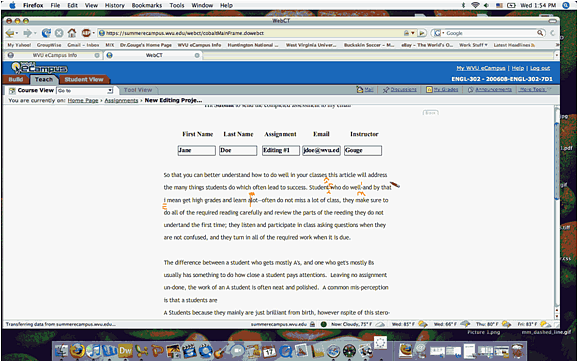
Figure 2. Using Draw function to create Red Copy Marks.
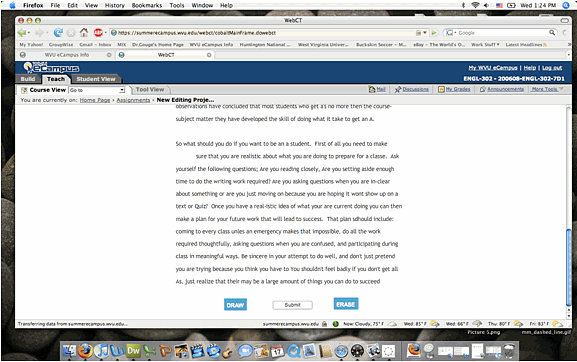
Figure 3. Click Submit to send page as a .pdf file.
If they make a mistake, they can click the “Erase” button and use the same process to erase any marks or portions of marks on the electronic page before them. When they are done, they simply click submit and the assignment is sent to me as a .pdf file (Figure 3). To assess these assignments, I can then open the file into a “draw” program on my computer, add my corrections or marks, attach the file to an email, type a personalized response for the student, and mail it back to him or her as a .pdf.
Two non-graded, self-evaluating practice copyediting exercises, also authored in Flash, which present students a paragraph with errors they need to identify and roll over with their mouse. This action will reveal to them three copyediting corrections: a, b, and c (Figure 4). One of these is the correct mark used correctly to fix the error in the text, and the other two are either the correct mark used incorrectly or the incorrect mark. The student chooses the one he or she thinks is correct and is immediately given a green “Correct” response or a red “Incorrect” response. If the correct response is chosen, then student will then see the copy mark incorporated into the text (Figure E) and can move on to the next error and proceed through the same actions.
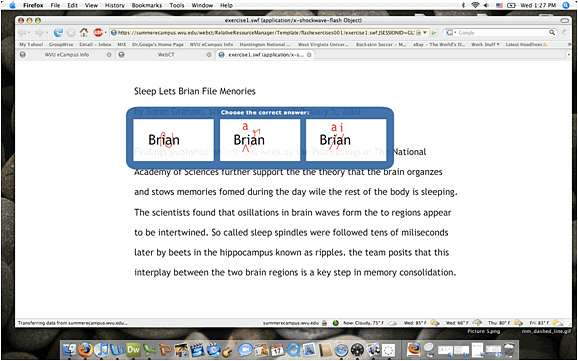
Figure 4. Choose from three copyediting corrections
Two copy-marking demonstrations authored in “Captivate” which show copy marks as they are drawn onto the page (Figures 5 and 6). Students have the capability to stop, pause, rewind, and play again each of the demonstrations using buttons at the bottom of the screen. Something we are planning to add to these in the near future are my voiceovers which explain how and why the marks are made as they are and how to avoid some common pitfalls in drawing each mark. For example, I will explain to them that they need to make sure each end of the “transpose” symbol fully extends above and below the letters or words intended to be transpose and to make sure that neither crosses through adjacent lettering or words or accidentally includes them in the instruction to transpose. The demonstrations run off of a streaming server at the university and will work for students with slower internet connections because we have kept the files small and the marks to a minimum.
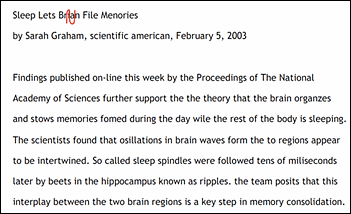
Figure 5. Copy editing and marking demonstration.
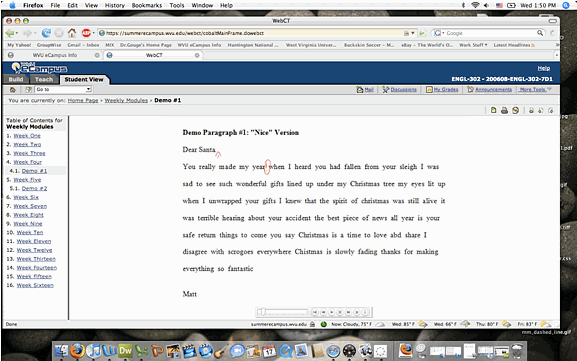
Figure 6. Copy marking demonstration.
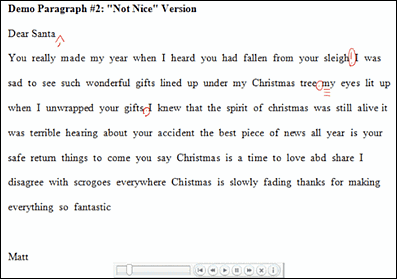
Figure 7. Marking edits.
New visual elements were also added to the course. These carry the content of the course into the look and feel of the course by using the visual of the copy-mark as a “branding” image. For example, icons on the course home page incorporate copy-marks into the names of the items to which they link (Figure 8).
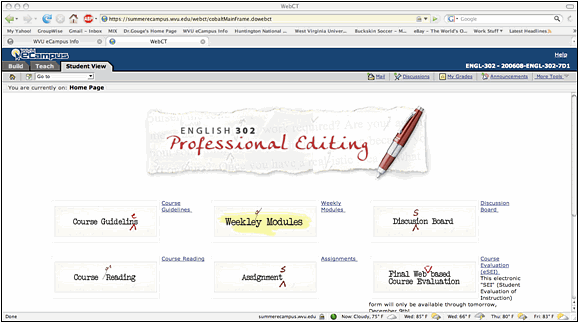
Figure 8. Copy marks on the course homepage.
Did the Redesigned Course Work in the Service of Program Integrity?
All of these new elements were created with the intention of helping the redesign achieve the four basic goals I outlined earlier: improving accessibility, increasing practice opportunities, drawing on appropriate technologies, and emphasizing current workplace skills. Each of the new elements will enable the class to be conducted 100% online and increase the speed with which instructor feedback can be provided to students. This will ensure that feedback is timely and allows students to learn from prior assignments before having to submit subsequent ones. Students should not be waiting for the postal service to hand-deliver their feedback days or weeks after the next assignment is due. Each of the new course elements also draws on a much wider range of technologies and tech skills for course interaction and assessment. Instead of just using Microsoft Word and WebCT/Blackboard to engage with the course, students are watching (and listening in future) to demonstrations, practicing identifying errors with low-stakes non-graded interactive multiple choice exercises, and practicing drawing copy-marks on the page using Flash coded assessments. In newly added assessments that are required later in the term students will practice more current editing-specific work place skills by using the “Track Changes” and “Comment” functions to compete an editor-writer project for which every student is a writer who works with another student editor online and an editor who provides editorial assistance to a student writer.
While we were able to complete and revise the basic content of the new elements, not all of them were able to be implemented in my pilot of the redesigned course in Fall 2006. After having students complete their first copy editing project the “old-fashioned way” (using the postal service), I released a Flash-coded version of the same text to students and asked them to try it and give me feedback about using the Flash assessments versus the print, mark, and send method. I also tried to complete the assessment as a “demo student” in our CMS. Sadly, all of us experienced some bugs that will make it impossible to use these assignments without further work. While I and others had tested the ease with which one could draw copy-marks in the assessment, this function proved to be too difficult to manipulate for many students and will need to be tweaked a bit to be less sensitive to the slightest motions. Perhaps the biggest problem we encountered, however, was the submission function. While it had worked in our trial period, when it went implemented and “live” in the class, it would not send me a copy of the submission as .pdf attachment to an email. The code will need to be reworked to fix this.
Once the obvious access issues created by these technical glitches are resolved, the most significant questions to reflect on with regard to the completed redesigned editing course is, “Does the redesigned course motivate and support student learning? Does is facilitate faculty satisfaction? And, therefore, does it help strengthen program integrity”?
Student Feedback
Students in the pilot of the newly redesigned course in Fall 2006 reported in anonymous course evaluations that they appreciated the variety of web-based interactive elements that the demonstrations and non-graded, self-evaluating exercises allowed for. Of course, none of them had taken the course any other way, so they could not compare the new elements to prior versions of the course. In response to the question, “Will you please make one suggestion that might help improve your experience of this course,” a small percentage of students (18%) made the suggestion that more of the newly-added non-graded practice exercises be incorporated into the course. For the most part, however, evaluations showed that what students valued most about the structure of the course was not any one individual demonstration or other aspect of the course (no matter how sophisticated the technology used to support it); rather, students reported that they appreciated the variety of interactivity and opportunities to communicate with me and their classmates encouraged and made possible by the course structure. 90% of students cited the message board interaction with me and their peers as the most useful to their learning in the course because, as one student wrote, “Especially if you are in need of help—it puts it out there for all to see and possibly offer advice.” The other 10% cited the textbooks as the most helpful. One student explained that this was “how it had always been.”
These student responses are, I believe, further evidence that no matter what the delivery method for a course—100% online, partially online, or on-site—students tend to value their personal, affective interaction with their instructors and other students over all else (texts, specific activities or assessments, etc.). This is a departure from some models of online writing program administration like that at Texas Tech University, where their hybrid writing program (ICON) separates “classroom instructors” from “document instructors” and students have the opportunity to never develop the affective relationship with those evaluating them (“The Benefits of Anonymous Grading,” 2006). Across the board, students in my pilot section noted that new interactive elements incorporated in the redesign provided them with more and different opportunities to practice what they were learning, and they reported that this was helpful to their learning. However, more important to their learning from their perspective was the fact that they were able to get lots of personal, timely feedback from me and their peers. This is not a response that is unique to the online editing course. Similar to our on-site counterparts, students in all of the online courses we offer in the English Department report that they value the personal feedback they are able to get from their instructors who know them by name, something they do not report getting enough of from online and on-site courses offered by many other departments. For this reason, each of the web-based courses we offer at WVU will continue to place a strong emphasis on this kind of interpersonal engagement by keeping class size small (16 students max) and using a variety of communication tools—large and small group message board discussion, synchronous chats, and email exchange.
Once the major kinks are worked out in the Flash authored editing projects are worked out, I strongly believe that students will value more highly the new interactive elements embedded in the redesign. The new elements will allow students to view and practice the on-screen version of copyediting prior to their first graded attempt. This will give the instructors more of an opportunity to talk about the process with students and students will appreciate having the on-screen practice. This viewing and practice, I noticed in my pilot of the course, really served as learning tools for students since it raised common questions before the first graded copyediting assessment. This resulted in higher grades on that assessment than in prior terms. Perhaps more importantly—from a student learning perspective—the more advanced first assessment attempt allowed me to give personalized feedback to students that would help them complete and even more sophisticated response to their second assessment. This is incredibly positive since the faster students improve, the more they can learn over the term.
Faculty Feedback
Because I am the only faculty member to have taught both the original and redesigned version of the editing course, I can only offer reflections based on a sample of one at this point. However, because I design, pilot, and then train others to teach our web-based courses, it is in my best interest to be critical of and thoughtful about them and to do my best to imagine what the experience of teaching them is likely to be for instructors with less online—and on-site in may cases--teaching experience than I.. With this in mind, my assessment of the potential for “faculty satisfaction” in the redesigned course is a mixed bag.
On the positive side, student experiences viewing and actually trying to choose marks can be used as prompts for discussion preceding their first submission of a graded copyediting project, and this will be tremendously helpful to instructors. Prior to having the interactive element, students had to practice the placement and articulation of the marks with their first editing project submission. This meant that instructors needed to extrapolate from student errors and respond to common misunderstandings during the evaluation of the first project. However, having the student experiences with the on-screen demos and exercises prior to the first project submission means that instructors can talk through common misunderstanding with small or large groups on the discussion board. On the first assessment, instructors can then respond to difficulty more specific to each student’s response to the assignment than the common first-attempt issues.
Too much extra labor time and stress will quickly kill faculty satisfaction with a course. In a web-based course, technical difficulties are the easiest way to increase labor time and add stress because this means a lot more time must be invested in maintaining the course environment and keeping students engaged. In fact, in some cases, this may mean that less time can be spent actually teaching students about the course content—which will negatively influence both student learning and faculty satisfaction. Additionally, the stress created for instructors by having to talk their students through technical breakdowns in the course on top of their own technical difficulties can be supremely difficult and unsatisfying, to say the least.
Program Integrity
In order for the positive elements of the new course design to outweigh the negative for both students and faculty, clearly the technical wrinkles must be ironed out first. No matter how promising they are, there is no benefit to adding more sophisticated technical elements if they don’t work. But once that is done, the resulting redesigned course will be one which more effectively accomplishes both the general and specific goals for the course. With the full integration of the new elements, the course will motivate and support student learning, facilitate faculty satisfaction, strengthen program integrity. It will, furthermore, improve accessibility of instructor feedback by moving assessments, including editing project, 100% online; increase the number of opportunities for students to practice editing in electronic environments; draw on a wider range of technologies and tech skills for course interaction and assessment; and emphasize more current editing-specific work place skills.
References
“The Benefits of Anonymous Grading,” Texas Tech TOPIC webpage: http://ttopic.english.ttu.edu/manual/manualread.esp. Accessed on June 7, 2006.
Brookfield, S. D. (2000). The concept of critically reflective practice. In A. L. Wilson & E. R. Hayes (Ed.). Handbook of Adult and Continuing Education (pp. 33-49). San Francisco: Jossey-Bass.
Conti, G. (2004). Appendix B: principles of adult learning scale. In M. Galbraith (Ed.), Adult learning methods: A guide for effective instruction (pp. 87-91). Malabar, Florida: Krieger Publishing Company.
Hammond, Nick and Annie Trapp (November 2002). “The Impact of the Web on Teaching, Learning and Assessment: A Survey of UK Departments of Psychology” Presentation at Society for Computers in Psychology Annual Meeting, Orlando, Florida.
Knowles, M. S. (1970). The modern practice of adult education: Andragogy versus pedagogy. New York: Association Press.
Program in Course Redesign (PCR): Outcomes Analysis. Retrieved July 9, 2007, from http://www.thencat.org/PCR/Outcomes.htm
Rhoda, K. I. (2005). The role of distance education in enhancing accessibility for adult learners. In L. Bash (Ed.), Best practice in adult learning (pp. 149-172). Bolton, MA: Anker Publishing Company, INC.
Rude, Carolyn. (2005). Technical Editing (4th ed.). New York: Longman.
Salemi, Vicki. “Do eDegrees Measure Up in the Workplace?” AOL.com. Accessed on March 1, 2006.
Sloan Consortium. Growing by Degrees: Online Education in the United States, 2005.
Wiley, Jennifer and Jonathan Schooler. (2000). “The Mental Web: Pedagogical and Cognitive Implications on the Net,” Learning and Teaching on the World Wide Web. New York: Academic Press.
About the Author
Catherine Gouge | Catherine Gouge is an Assistant Professor of English at West Virginia University. She has designed courses for, taught in, and coordinated an online Professional Writing and Editing undergraduate program since 2001. Dr. Gouge’s research interests include online pedagogy and program administration, digital media, technology and cultural studies, and American popular culture. Catherine Gouge, Ph.D. Phone: (304) 293-3107 Email: cgouge@wvu.edu
|
EndNotes
[1] Under the prevue of this project, the Center awarded $6 million in grants to ten different institutions in three rounds (so a total of 30 projects). For more on these, visit http://www.center.rpi.edu/PCR.
[2] At West Virginia University, we currently have such support from two departments: One is called the Instructional Technology Resource Center (ITRC) and the other is called the Office of Information Technology (OIT). The ITRC will work with faculty on specific course design or redesign projects, while OIT is primarily in the business of providing training sessions on new programs and technology and managing a dedicated 24/7tech support hotline.
[3] I emphasize here that this deadline is for “Technical Editing” because the other writing online classes in the sequence share the fact of a consistent weekly deadline, though the day differs depending on the course so that students taking multiple courses in the sequence will not have all of their weekly deadlines fall on the same day.
[4] Assessment processes, for example, should not have as their goals anonymity (of student or evaluators) or objectivity. Cf. Texas Tech article(s). I don’t mean by this that assessment shouldn’t be “consistent,” but that we should not claim or strive to be anonymous or indifferent to the specific rhetorical details of student work. In my article(s) on this topic, I explain this in more detail.
